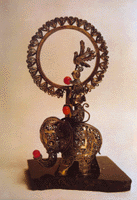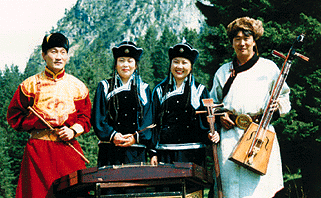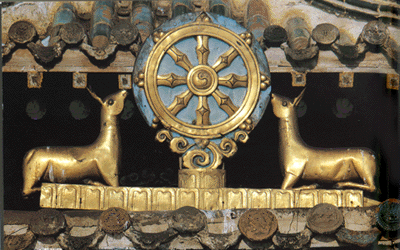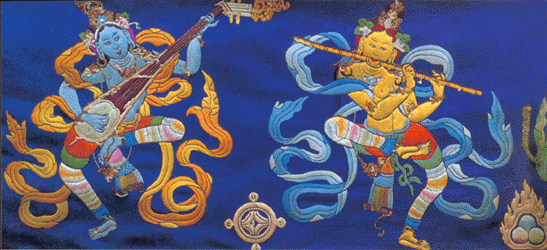|
- Catalog (in stock)
- Back-Catalog
- Mail Order
- Online Order
- Sounds
- Instruments
- Projects
- History Face
- ten years 87-97
- Review Face
- our friends
- Albis Face
- Albis - Photos
- Albis Work
- Links
- Home
- Contact
- Profil YouTube
- Overton Network
P & C December 1998
- Face Music / Albi
- last update 03-2016
|
1. Tungalag tamir - 16:19
2. Dörvön tsag - 17:25
3. Tooroi bandi - 27:04
4. Tsevtsger khurdan sharga - 12:06
 |
Tumbash is a symbol for four animals, which live peacefully and happily together. According to an Indian fairy-tale, a pigeon, a hare, a monkey and an elephant lived peacefully and happily together and respect the older. Thanks to their friendship and peaceful togetherness, they had been able to achieve a lot. These animals helped an oppressed people to free themselves from the authorities. By holding together with this people, they could overcome the evil prince and chase away.
The word "tumbash" is also mentioned in the ancient Sutra "Subashid", the Treasure of Wisdom.
|

Enkhjargal, Selenge, Sarangerel, Batgerel
Songs
1. Tungalag tamir - long song - urtyn duu
- Batgerel: morin khuur
|
This is a wishing song. A Mongol takes a rest on the Tamir River (his place of birth), in which clear (tungalag = clear) water is flowing. While looking at the flowers and the nature along this river, he wishes everlasting friendship with his beloved one and that he may be happy and in love for all his live. He also wishes to remain young forever and so everything should be as in his youth together with his friends.
|
2. Dörvön tsag - long song - urtyn duu
- Enkhjargal: limbe, Selenge: yoochin
|
(Four seasons = dörvön tsag). The Mongols compare their partners with the four seasons. If someone chooses a bad partner, this is stupid and usually leads to troubles. A tree can produce good fruit and nuts and like this it can be with the chosen partner.
|
3. Tooroi bandi - long song - urtyn duu
Enkhjargal: limbe, Batgerel: morin khuur
|
A Mongolian woman misses her bright lover called Tooroi bandi. She sings passionately about his special character, his particular qualities and his heroic deeds.
|
He had refused to render homage to the authorities (the Manchu) and had resisted their oppression. He doesn't fear the punishment and he doesn't feel cold. When the sun shines, he doesn't feel its heat.
She brings him a piece of cheese with a file inside and she says to him: You must know for yourself how to get out of here.
|
Everybody esteems him for his defying the authorities. Therefore, people love and honour him.
|
4. Tsevtsger khurdan sharga - long song - urtyn duu
- Enkhjargal: limbe
|
(Tsevtsger khurdan sharga = a beautiful, light brown racehorse).
|
A Mongol is preparing himself and his racehorse for a meeting with his beloved one. He adores her cleverness and compassion and enjoys her beauty. He compares her beauty with the beautiful landscape, the mountains and the rivers. He wants to ride with his horse along the valleys and lead a happy live with his beloved one, without boredom and never forgetting her.
|
|
- Urtyn duu - long song are melismatic and richly ornamented, in a slow tempo, with long melodic lines, wide intervals and without any fixed rhythm.
|
They are sung in verses, without any regular refrain and with full voice in the highest register. The melody has a coat that covers over three octaves. This requires a strict observance of the breathing rules. The breathing is actually free, but the singer has to keep to the strict rules of performance, making only the absolutely necessary breathing breaks without interrupting the melodic ornaments. The richer the voice is and the longer the singer can hold it, the more intensive is the attention paid by the auditors and the more his performance is appreciated.
|
The people practise these long songs mostly while being alone in the open steppe and riding along slowly. The repertory is an expression of the liberty and the vastness of the Mongolian steppe and is used to accompany the rites of the seasonal cycles and the ceremonies of everyday life. Long songs are an integral part of the celebrations held in the round tents and they must be sung after the strict rules of performance.
|
| There are three categories of long songs: |
|
- The extended ones with uninterrupted flowing melodies, richly ornamented, containing long passages in falsetto. |
|
- The usual ones are shorter, less ornamented and without falsetto. |
|
- The shortened ones have short verses, refrains and melodic courses full of leaps and bounds.
|

The Wheel of the World - a symbol in Buddhism
Instruments:
|
- Morin khuur (string instrument - horse-head-violin)
|
|
The morin khuur is a typical Mongolian two-stringed instrument. The body and the neck are carved from wood. The end of the neck has the form of a horse-head and the sound is similar to that of a violin or a cello. The strings are made of dried deer or mountain sheep sinews. It is played with a bow made of willow, stringed with horsetail hair and coated with larch or cedar wood resin.
|
|
This instrument is used to play polyphonic melodies, as with one stroke of the bow the melody and drone-strings can be played at the same time. The morin khuur is the most widespread instrument in Mongolia, and is played during celebrations, rituals and many other occasions, as well as an accompaniment for dances or songs. Even the sound and noises of a horse herd are imitated on the morin khuur.
|
|
People say that it is connected with a handsome man. It is also played when a ewe doesn't want to suckle her lamb.
|
|
There is a legend about the origin of this instrument. A Mongol missed his dead horse so much that he used its head, its bones and its hair to build an instrument on which he started to play the familiar noises of his beloved horse.. |

left: shudraga / schanz (string instrument) - right: limbe (wind instrument)
|
- Yoochin (string instrument)
|
|
The yoochin is a box zither, a dulcimer with 13 double-wire strings. The strings are struck with two wooden sticks, so-called little wooden hammers (it is comparable with the santur of the Persians). It has a black wooden soundboard richly decorated with ornaments.
|
|
The instrument was only familiar to townspeople and in the beginning of all only they played it.
|
|
- Limbe (wind instrument - transverse flute)
|
|
The instrument is frequently used in accompaniment, occasionally also as a solo instrument. In former times, these flutes were made of bamboo or wood, nowadays mostly of plastic, particularly the instruments that are imported from China. These flutes are closely bound up with the nomads of Central Asia.
|
|
The length of the instrument is approx. 64 cm, with nine holes, whereof one is the blowhole and two others are reserved for the tuning. It is often played with circular breathing*. The sound reflects what is heard in the nature or the sounds of the natural and social environment.
|
|
*Circular breathing: one note is blown, while the musician inhales through his nose. The air is collected inside the cheeks and exhaled by the pressure of the cheeks' muscles (same principle as for the bagpipe). The base of the tongue is used as a valve.
|
-More information on the history of the Mongols and traditional songs from Mongolia see:
- Duo Temuzhin, "Altai-Khangain-Ayalguu", FM 50023
- Ensemble Temuzhin, "Altai-Khangain-Ayalguu 2", FM 50026
- Ensemble Ardiin Ayalguu, Solongo, FM 50024.
Many thanks to Enkhjargal Chuluunbaatar, Selenge Zangad, Batgerel Tsegmed , Sarangerel Shagdarsuren, Oyuntuya Saldan and Silvia Delorenzi-Schenkel for helping with the translation.
|
